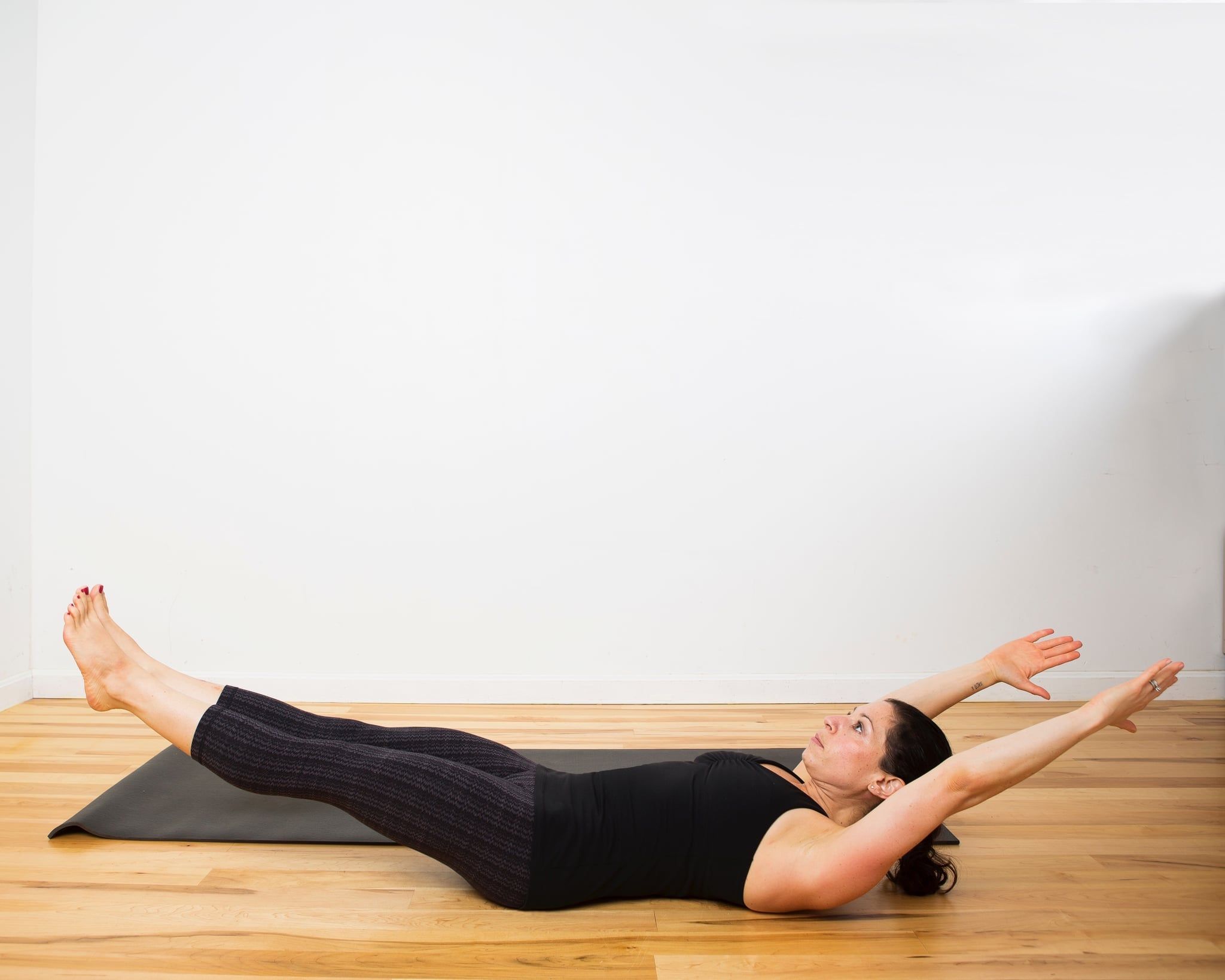The hollow hold is a popular core exercise that targets the deep abdominal muscles, including the rectus abdominis, transverse abdominis, and obliques. It is a challenging exercise that requires strength, stability, and body control. In this comprehensive guide, we will take you through the steps to perform the hollow hold correctly, variations to make it more challenging or accessible, and the benefits of incorporating this exercise into your fitness routine.
Proper Technique:
To perform the hollow hold, follow these steps:
a. Lie flat on your back with your arms extended overhead and your legs straight.
b. Engage your core by pressing your lower back into the floor. This will help protect your spine and ensure proper alignment.
c. Lift your shoulder blades and legs off the ground simultaneously. Imagine hollowing out your belly and pulling your ribcage down towards your hips.
d. Keep your lower back pressed into the floor and your lower abs engaged. Avoid arching your back or allowing your lower ribs to flare out.
e. Hold this position for the desired amount of time while maintaining proper form and breathing steadily.
Common Mistakes to Avoid:
When performing the hollow hold, it’s essential to watch out for these common mistakes:
a. Arching the lower back: This can strain the lower back and take the focus away from the core muscles. Keep your lower back pressed into the floor throughout the exercise.
b. Allowing the legs to drop too low: Lowering the legs too close to the floor can compromise form and reduce the effectiveness of the exercise. Aim to keep your legs at a 45-degree angle or higher.
c. Holding tension in the neck and shoulders: Try to relax your neck and shoulders while engaging your core. Excessive tension in these areas can lead to discomfort and poor form.
Progressions and Variations:
Once you have mastered the basic hollow hold, you can incorporate these progressions and variations to challenge yourself further:
a. Tuck Hollow Hold: Instead of extending your legs straight, bend your knees and bring them towards your chest. This increases the difficulty by adding more leverage and engagement of the core muscles.
b. Hollow Hold with Leg Extensions: Start with the basic hollow hold position and extend one leg out while keeping it just above the ground. Alternate legs in a controlled manner while maintaining a stable core.
c. Hollow Hold Roll-Ups: Begin in the hollow hold position and then roll up into a V-sit position, engaging your core and hip flexors. Slowly roll back down to the starting position. This variation adds an extra challenge for the core and hip flexor muscles.
d. Weighted Hollow Hold: Hold a weighted object, such as a dumbbell or medicine ball, on your chest while performing the hollow hold. This adds resistance and increases the intensity of the exercise.
Benefits of Hollow Hold:
Incorporating hollow holds into your fitness routine offers several benefits:
a. Core Strength: Hollow holds primarily target the deep abdominal muscles, helping to develop core strength and stability. A strong core is essential for maintaining proper posture, improving athletic performance, and reducing the risk of back pain and injuries.
b. Improved Body Control: Hollow holds require coordination and body control to maintain proper form. Regular practice can enhance your overall body awareness and control during other exercises and daily activities.
c. Postural Alignment: By strengthening the core and promoting a neutral spine position, hollow holds contribute to improved posture. They help counteract the negative effects of prolonged sitting and sedentary lifestyles.
d. Functional Fitness: The hollow hold mimics the core engagement needed in various sports and physical activities. By training the core muscles in a functional manner, you can improve your performance in activities such as running, jumping, and lifting.
Incorporating Hollow Holds Into Your Workout Routine:
To reap the maximum benefits from hollow holds, consider the following tips:
a. Start with proper form and gradually increase the duration of the hold as you get stronger.
b. Incorporate hollow holds into your core workout routine 2-3 times per week.
c. Combine hollow holds with other core exercises, such as planks, Russian twists, and bicycle crunches, to create a well-rounded core training program.
d. Listen to your body and progress at a pace that feels challenging but manageable. Avoid pushing yourself too hard and risking injury.
In conclusion, the hollow hold is a highly effective core exercise that targets the deep abdominal muscles and promotes core strength, stability, and body control. By following the proper technique, avoiding common mistakes, and incorporating progressions and variations, you can take full advantage of the benefits offered by this exercise. Remember to start slowly, focus on form, and gradually increase the intensity to achieve optimal results. So, get ready to strengthen your core and take your fitness to the next level with the hollow hold!
Hollow Hold: A Complete Guide
The hollow hold is a popular core exercise that targets the deep abdominal muscles, including the rectus abdominis, transverse abdominis, and obliques. It is a challenging exercise that requires strength, stability, and body control. In this comprehensive guide, we will take you through the steps to perform the hollow hold correctly, variations to make it more challenging or accessible, and the benefits of incorporating this exercise into your fitness routine.
Proper Technique:
To perform the hollow hold, follow these steps:
a. Lie flat on your back with your arms extended overhead and your legs straight.
b. Engage your core by pressing your lower back into the floor. This will help protect your spine and ensure proper alignment.
c. Lift your shoulder blades and legs off the ground simultaneously. Imagine hollowing out your belly and pulling your ribcage down towards your hips.
d. Keep your lower back pressed into the floor and your lower abs engaged. Avoid arching your back or allowing your lower ribs to flare out.
e. Hold this position for the desired amount of time while maintaining proper form and breathing steadily.
Common Mistakes to Avoid:
When performing the hollow hold, it’s essential to watch out for these common mistakes:
a. Arching the lower back: This can strain the lower back and take the focus away from the core muscles. Keep your lower back pressed into the floor throughout the exercise.
b. Allowing the legs to drop too low: Lowering the legs too close to the floor can compromise form and reduce the effectiveness of the exercise. Aim to keep your legs at a 45-degree angle or higher.
c. Holding tension in the neck and shoulders: Try to relax your neck and shoulders while engaging your core. Excessive tension in these areas can lead to discomfort and poor form.
Progressions and Variations:
Once you have mastered the basic hollow hold, you can incorporate these progressions and variations to challenge yourself further:
a. Tuck Hollow Hold: Instead of extending your legs straight, bend your knees and bring them towards your chest. This increases the difficulty by adding more leverage and engagement of the core muscles.
b. Hollow Hold with Leg Extensions: Start with the basic hollow hold position and extend one leg out while keeping it just above the ground. Alternate legs in a controlled manner while maintaining a stable core.
c. Hollow Hold Roll-Ups: Begin in the hollow hold position and then roll up into a V-sit position, engaging your core and hip flexors. Slowly roll back down to the starting position. This variation adds an extra challenge for the core and hip flexor muscles.
d. Weighted Hollow Hold: Hold a weighted object, such as a dumbbell or medicine ball, on your chest while performing the hollow hold. This adds resistance and increases the intensity of the exercise.
Benefits of Hollow Hold:
Incorporating hollow holds into your fitness routine offers several benefits:
a. Core Strength: Hollow holds primarily target the deep abdominal muscles, helping to develop core strength and stability. A strong core is essential for maintaining proper posture, improving athletic performance, and reducing the risk of back pain and injuries.
b. Improved Body Control: Hollow holds require coordination and body control to maintain proper form. Regular practice can enhance your overall body awareness and control during other exercises and daily activities.
c. Postural Alignment: By strengthening the core and promoting a neutral spine position, hollow holds contribute to improved posture. They help counteract the negative effects of prolonged sitting and sedentary lifestyles.
d. Functional Fitness: The hollow hold mimics the core engagement needed in various sports and physical activities. By training the core muscles in a functional manner, you can improve your performance in activities such as running, jumping, and lifting.
Incorporating Hollow Holds Into Your Workout Routine:
To reap the maximum benefits from hollow holds, consider the following tips:
a. Start with proper form and gradually increase the duration of the hold as you get stronger.
b. Incorporate hollow holds into your core workout routine 2-3 times per week.
c. Combine hollow holds with other core exercises, such as planks, Russian twists, and bicycle crunches, to create a well-rounded core training program.
d. Listen to your body and progress at a pace that feels challenging but manageable. Avoid pushing yourself too hard and risking injury.
In conclusion, the hollow hold is a highly effective core exercise that targets the deep abdominal muscles and promotes core strength, stability, and body control. By following the proper technique, avoiding common mistakes, and incorporating progressions and variations, you can take full advantage of the benefits offered by this exercise. Remember to start slowly, focus on form, and gradually increase the intensity to achieve optimal results. So, get ready to strengthen your core and take your fitness to the next level with the hollow hold!
- Top Pet Products Reviewed A Comprehensive Guide By Science-Ritecbd - August 30, 2024
- CBD For Pets By Relievet-Comprehensive Review of Top CBD Products for Pets A Guide for Pet Owners - September 19, 2023
- Hollow Hold: A Complete Guide - July 12, 2023


